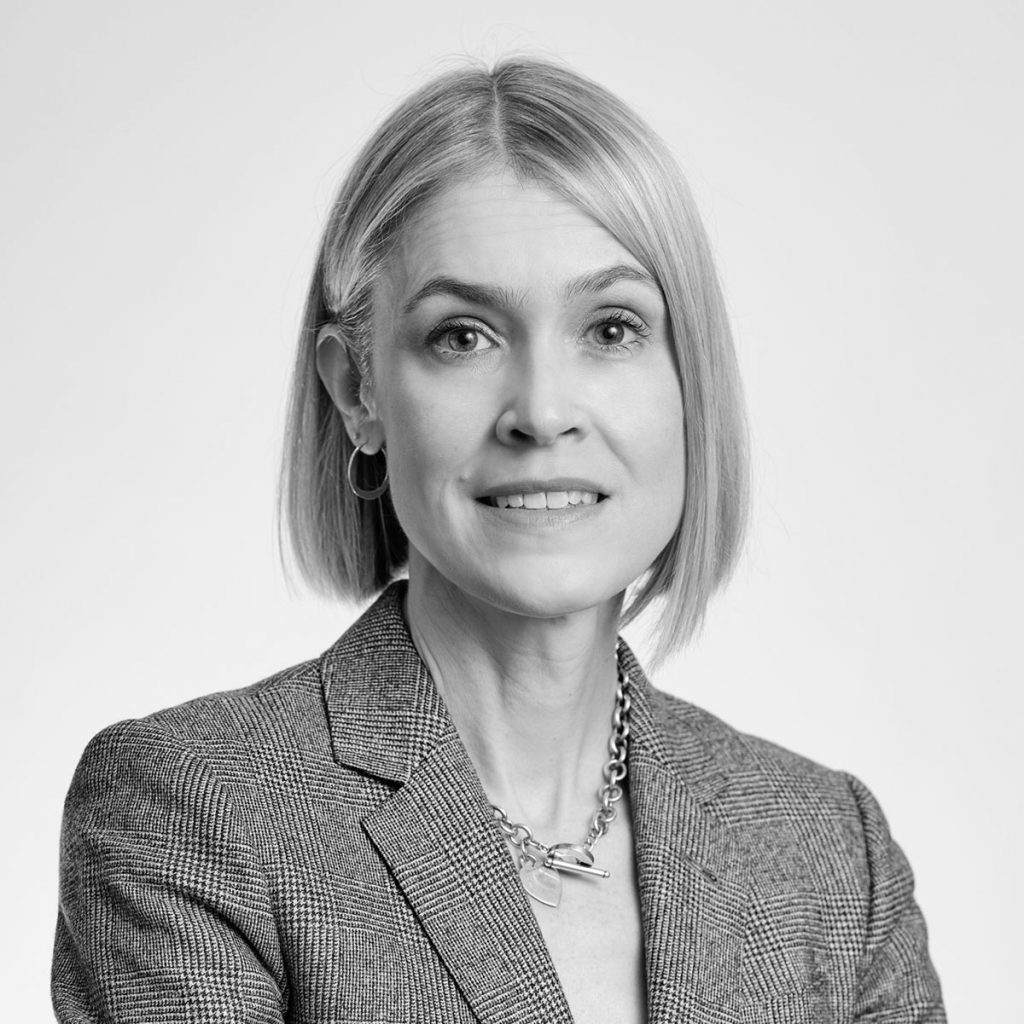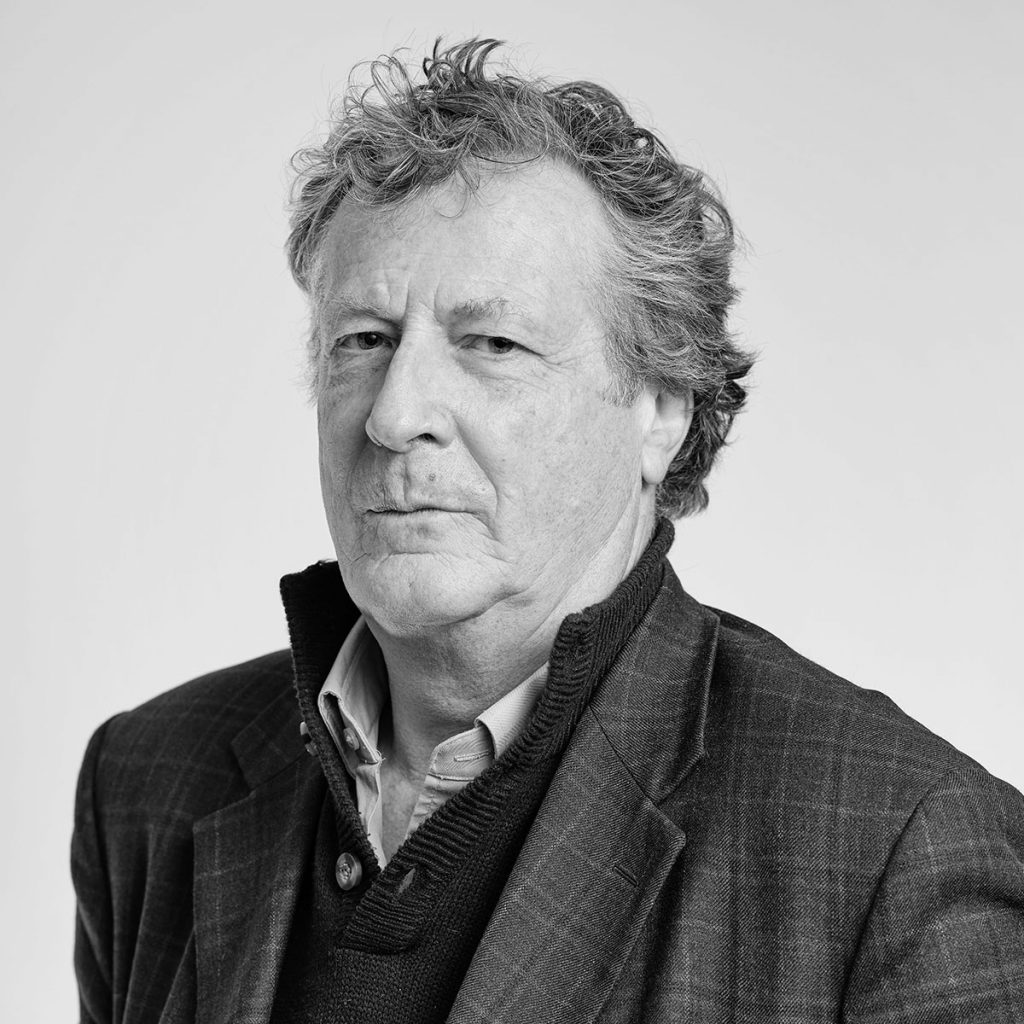With the year drawing to an end, the auction houses recently rallied for one last push with five major evening sales held between New York and Hong Kong across Phillips, Sotheby’s and Christie’s over the first two weeks in December. Representing what would have been the usual November slot, these sales were pushed back to December. However, despite Sotheby’s opting to move their ‘November sale’ forward to October, they curiously bookended this period with yet another evening auction, this time mixing Impressionist & Modern and Post-War & Contemporary lots, a tactic in line with Christie’s recent approach.
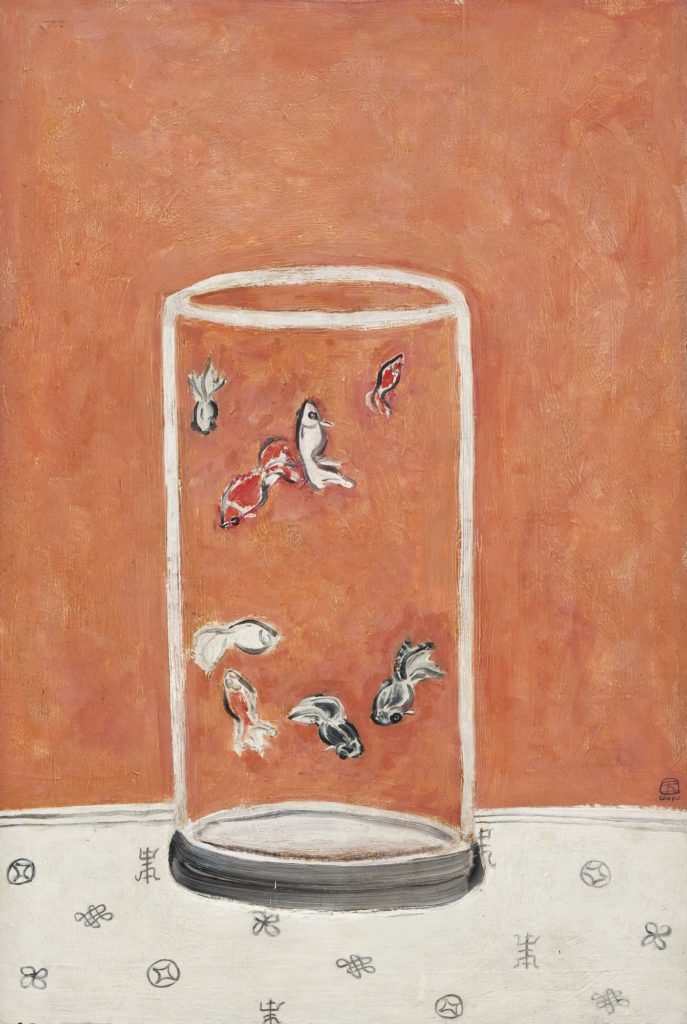
The Hong Kong sales showed remarkable strength and considerable depth of bidding when compared to the New York segments. Christie’s Hong Kong first held a fifty-eight lot Modern & Contemporary sale and a standalone one lot Sanyu sale. With all but one lot selling, the sale surpassed its presale estimate by 20% bringing in $132 million. This was followed a few hours later by the 20th Century department holding a ‘global sale’ starting in Hong Kong then moving on to New York, in a relay style similar to what we saw in July, totalling $119.3 million solidly within their presale estimations.
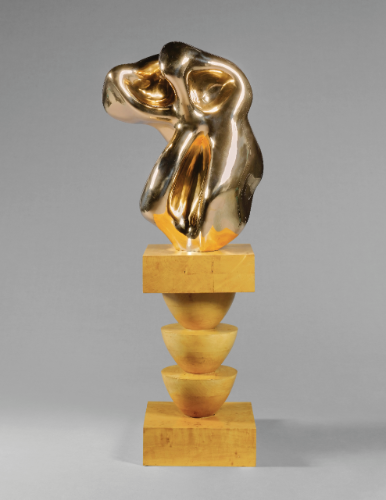
This appeared a risky gambit with major works by several artists such as Zao Wou-Ki, George Condo, Yoshitomo Nara included in both the Modern & Contemporary and One Sale Hong Kong segment. However, this overlapping of content did not seem to slow the appetite one bit, the One Sale Hong Kong was 100% sold. As Christie’s moved to their New York segment, bidding from Hong Kong continued long into the evening, including a Renoir painting towards the end of the sale which meant Asian bidders were active at 11.45 pm local time. More surprising, a sculpture by Hans Arp sold to a Hong Kong bidder in the room for $2.4 million including premium, as Georgina Hilton bid virtually for the collector with Adrian Meyer in New York.
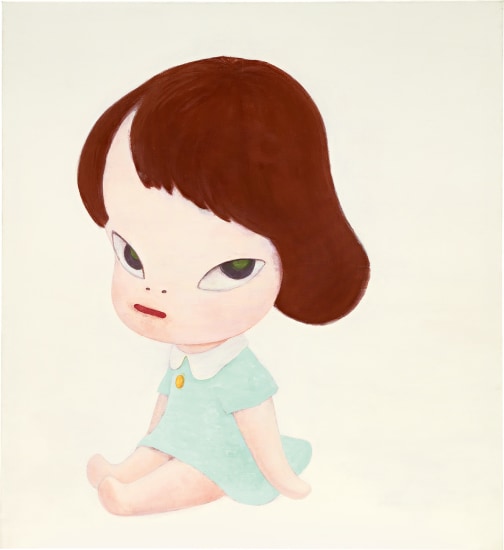
Phillips Hong Kong opted to hold their sale in partnership with Poly Auctions, one of mainland China’s biggest auction houses. The strategy paid off with only two unsold lots, the sale surpassed its presale estimate by around $10 million. Poly crucially expanded the bidding to mainland China which helped increase competition with Phillip’s Hong Kong bidders and ultimately pushed the price on several lots. Buyers leapt bidding increments by as much as HK$5 and HK$6 million at times. Most notably, a major 1995 painting by Yoshitomo Nara, initially chased by seven bidders, was fought over by Nick Hilton with Phillips Hong Kong and Blair with Poly Beijing, resulting in the work doubling the low estimate and selling for $13.3 million. It eventually sold to the same phone buyer that won the Matthew Wong and set the second highest price for the artist. Interestingly the partnership with Poly also led to more online bidding than we had seen in a while, clients from Singapore, Taiwan, Samoa and Korea, all underbid online for several of the top lots.
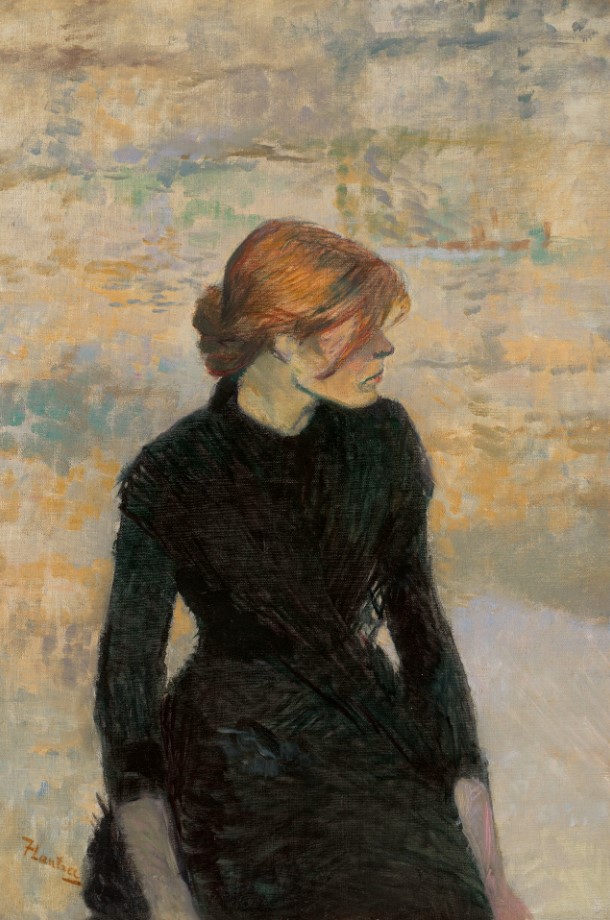
It was a very different feel during Christie’s New York One Sale segment which had five unsold lots compared to zero from the Hong Kong section and more than half of their lots sold on or below the low estimate. Their Post-War & Contemporary day sale also failed to reach the low end of its presale estimate. Intriguingly, the star evening sale lot was not a Contemporary work but a Toulouse-Lautrec, which had belonged to automotive head Henry Ford II. This attracted at least five bidders, all in New York, before selling well above estimate for $9 million including premium. 43% of the sale was guaranteed by value as the success of the sales continues to be assisted by financial backing.
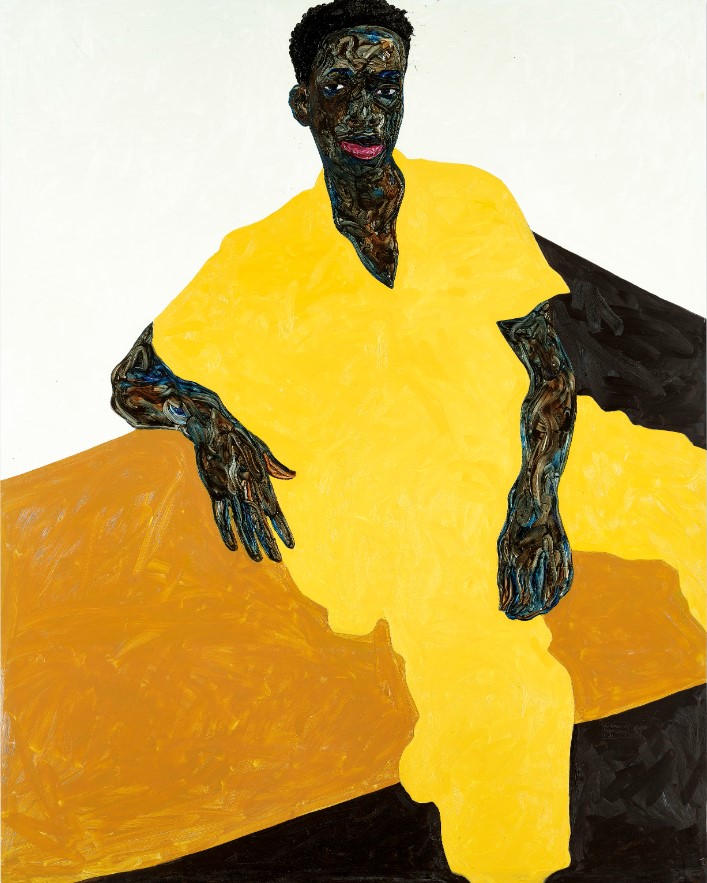
Throughout the sales a number of artist records were achieved. At Phillips both in Hong Kong & New York new records were set for Matthew Wong, Bernard Frize, Lucas Arruda, Emily Mae Smith, Vaughn Spann, Jadé Fadojutimi, Kehinde Wiley, Mickalene Thomas and Amy Sherald. Several artist records were achieved with Christie’s as well, including Salman Toor (surpassing the record Phillips set earlier that day) Georges Mathieu, Nicholas Party, Joyce Pensato, Dana Schutz, Amoako Boafo and Shara Hughes, amongst others (interestingly both the Boafo and Hughes were acquired by the same collector). And Sotheby’s reached a new record for Barkley L. Hendricks. The notable theme running through this list of records being major success for black artists and less well established artists, as ever increasing speculative buying rages on.

Phillips New York sale had significant weight in this area which contributed to the success of their evening sale, in disparity with the Christie’s New York and Sotheby’s sales being predominantly focussed on the traditional canon. Phillips achieved an extraordinary price for Amy Sherald, only the second work to come to auction the painting sold for $4.3 million with premium against an estimate of $150,000 – 200,000. Contrastingly, the top priced lots by evening sale regulars such as Jean-Michel Basquiat, Donald Judd and Clyfford Still saw more muted bidding. But their top lot by David Hockney did see the artist’s highest price for a landscape, selling to Cheyenne Westphal’s client for $41.1 million including premium.
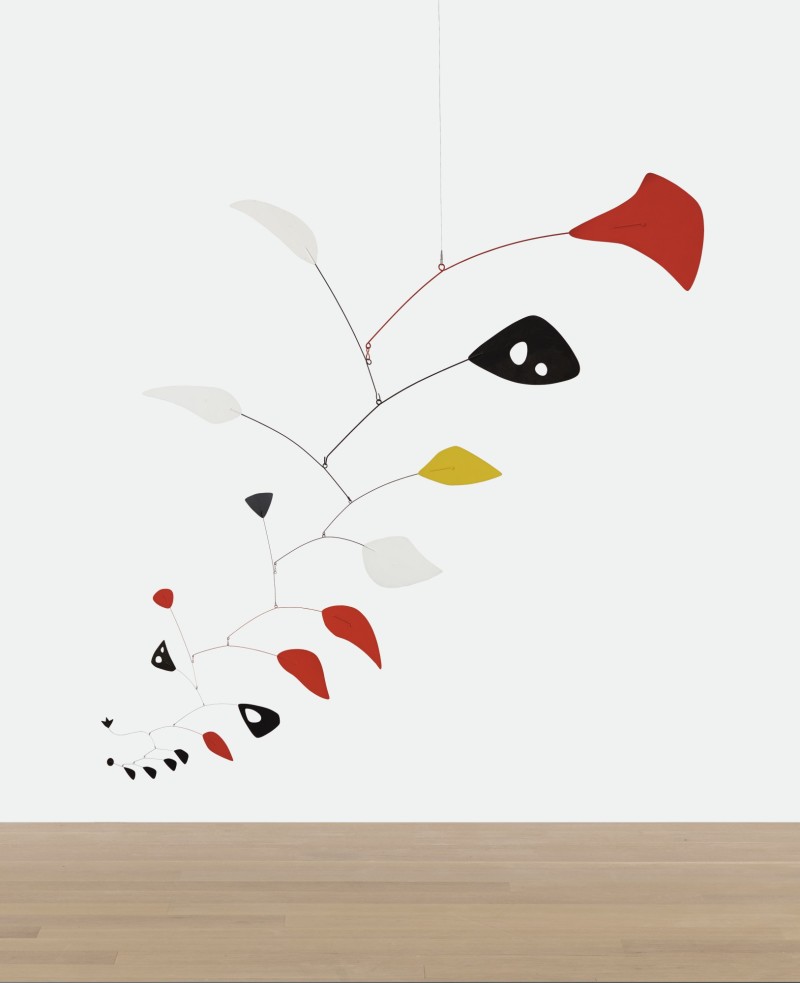
Sotheby’s only had two lots by ‘emerging’ artists and this affected the level of activity in their sale. Before the sale even began, they withdrew five lots with a combined low estimate of $10.1 million which perhaps attests to whether the new mixed category strategy paid off. For the remaining lots in the sale bidding was subdued bar for the expected Hendricks, Wong and remarkable Calder, their top selling lot of the evening. Some last-minute guarantees were put in place at half of the low estimate for works by Van Dongen and Achipenko. This benefitted their sell through rate but affected the bottom line.

Overall, Hong Kong showed considerably more vigour than New York, clearly the Asian economy has weathered recent events better than the US. However, Phillips New York’s results were encouraging, indeed it was the house’s highest ever evening sale total in that category. Evidently the market is currently buoyed by young artists and a sale tailored to this current demand is what’s required to see active bidding. Restrictions over seeing works in person continue to fuel this, the due diligence requirements for a 1950s Ab-Ex painting remain very different to a recent primary market piece, as well as the obvious economic factors. Volume continues to be another feature, the bulk of ‘marquee’ evening sales over the last few months is affecting demand. With the promise of yet another ‘major’ sale around each corner what is to stop collectors holding out and waiting to see what the market offers down the line. Hopefully, the break between now and the next round of London sales will bring much needed respite.
It will be interesting to see how the auction houses approach the next six months given the recent dramatically changed schedule. However, generally the overall strength in the performance over the past nine months has been impressive given the circumstances.
Image 1: Image courtesy Christie’s; Image 2: Image courtesy Christie’s; Image 3: Image courtesy Phillips; Image 4: Image courtesy Christie’s; Image 5: Image courtesy Christie’s; Image 6: Image courtesy Phillips; Image 7: Image courtesy Sotheby’s; Image 8: Image courtesy Sotheby’s
Further Reading
- The Asking Price: Understanding Value 1
- The Asking Price: Understanding Value 2
- Looking Forward: Ten Art Market Predictions for 2023
Following the success of our previous Virtual Breakfast Briefing back in July, this season’s Breakfast Briefing continues the trend of the virtual replacing the traditional IRL events, normally held at Christie’s, Sotheby’s, or Phillips around the world.
Senior Director Morgan Long and Managing Director Guy Jennings sat in virtual conversation with Philip Hoffman, discussing the recent auction sale results, and debating the movements and currents of the art market over the past few months.
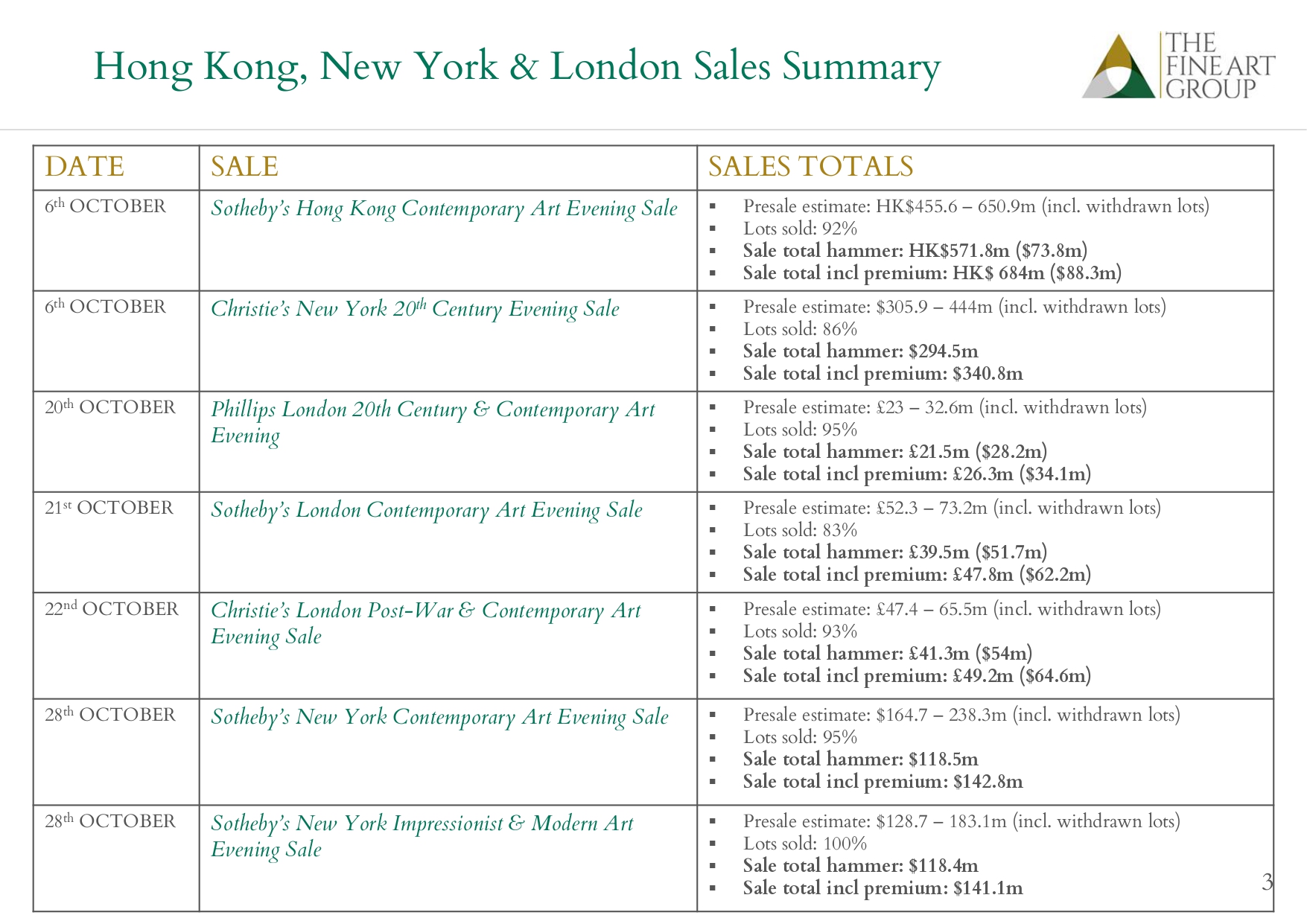
What happens when the title event of Frieze week is a no show? It’s complicated. The fairs themselves – Frieze London, Frieze Masters, an already postponed Photo London – mostly moved online, although 1:54 optimistically went ahead with an IRL event at Somerset House.
Some Frieze week absences are welcome – the tired feet, gallery dinner malaise, bushels of Gail’s Bakery receipts – but, unsurprisingly, without the usual international traffic in town, the mood was and remains calm, steady, muted. Without marquee auctions accompanying the week – the biggest sales to coincide with Frieze week were Christie’s mixed offerings in New York and Sotheby’s successful contemporary sale in Hong Kong – the heat of blue chip commerce has been deferred in London to later this month.
The online iterations of Frieze and Frieze Masters, finely tuned technologically and stronger than most, generally contributed to the growing consensus that we’ve passed peak online viewing room. Bigger galleries reported meaningful sales, but there were few surprises. No fair passes without Hauser & Wirth pointedly announcing sales of at least several objects for several million each, yet there seemed to be little mention of reported sales from Frieze Masters.
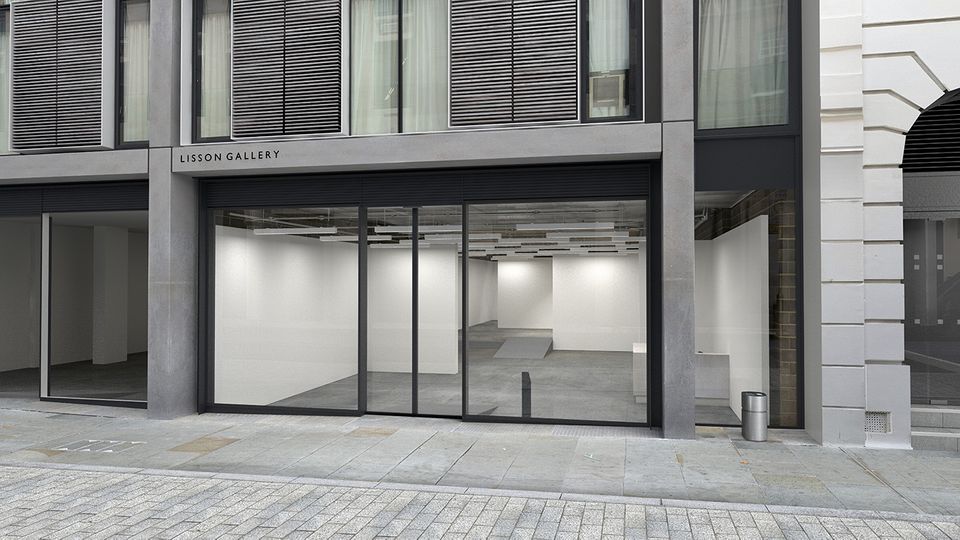
While operating at a less frenetic pace there is nonetheless considerable depth to the museum and gallery schedule in London. The closest the week came to the usual fair buzz was a few hours on the afternoons of Thursday 8th and Friday 9th October on Cork Street. Blue chips Lisson and Sadie Coles have opened temporary spaces on the street, both until the end of October. While South Africa’s Goodman Gallery is a relatively new but permanent addition to the new Cork Street development which has stood empty for more than eighteen months. Outsize at the north end of the street is the new venture Saatchi Yates. Nearly three years in the making, the business is run by Phoebe Saatchi (daughter of Charles) and her husband Arthur Yates. The opening show – a young artist, Pascal Sender – is reportedly close to selling out, with large works priced at 50,000 – 60,000 GBP.

Typically the time of year for grand openings, there are further new spaces in the city. Dealer Ben Hunter has taken on White Cube’s first space at 44 Duke Street, opening with a sell-out show of paintings by Sarah Ball. Soon to open on Margaret Street, Fitzrovia is Workplace Gallery – headquartered in Gateshead – with a solo presentation by young painter Louise Giovanelli. Other galleries opened temporary off-sites in the centre of town – most notably Rome’s Galleria Lorcan O’Neill in Mayfair, Project Native Informant in Soho and Edel Assanti at St Cyprian’s Church in Baker Street.
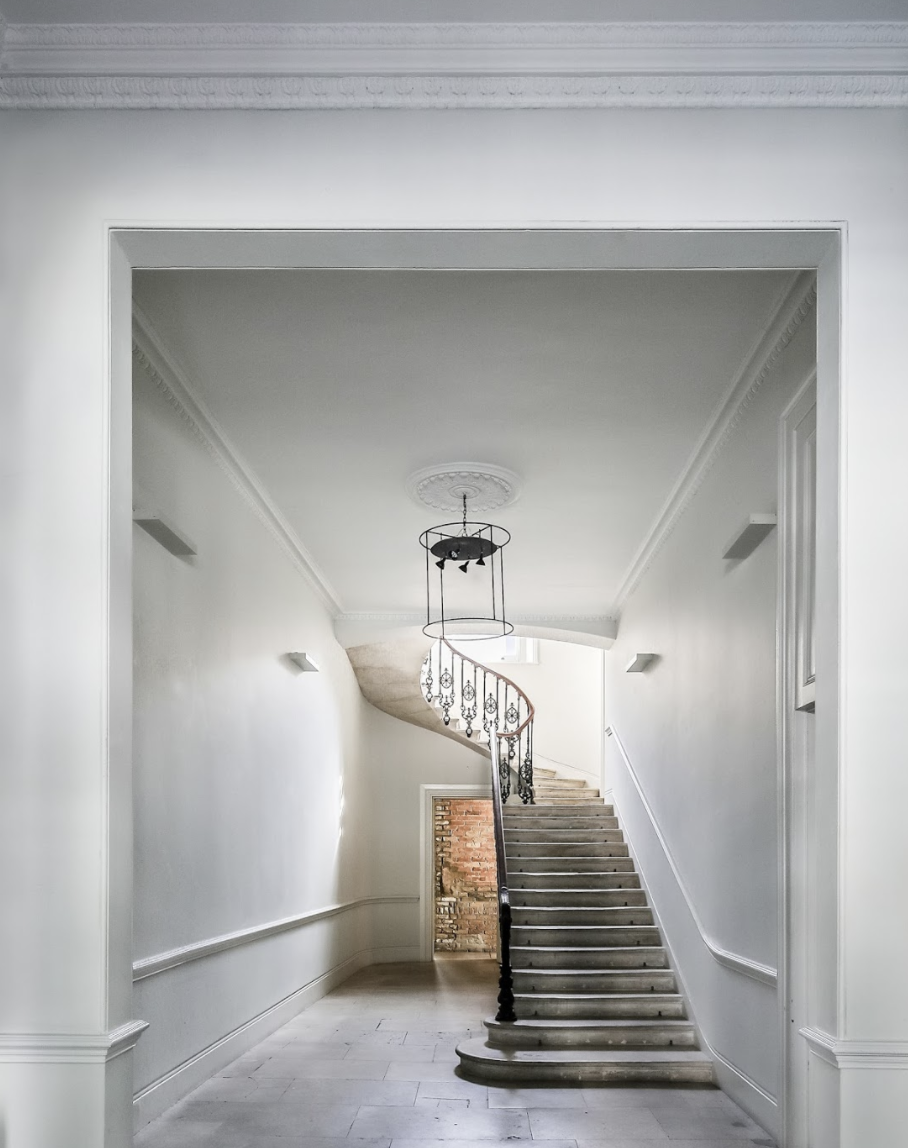
Long in the making is the opening of Cromwell Place, a much talked about development of several South Kensington town houses into a commercial arts ‘hub’, with gallery spaces for hire, offices, club rooms and professional storage. Conceived several years ago as a response to the increasingly peripatetic nature of the art market and the focus on particular, seasonal moments in the city, the operation has nonetheless opened with a mixed offering of current occupants, most notably Lehmann Maupin – who appear to be longer term residents than others – and Edinburgh’s Ingleby Gallery.
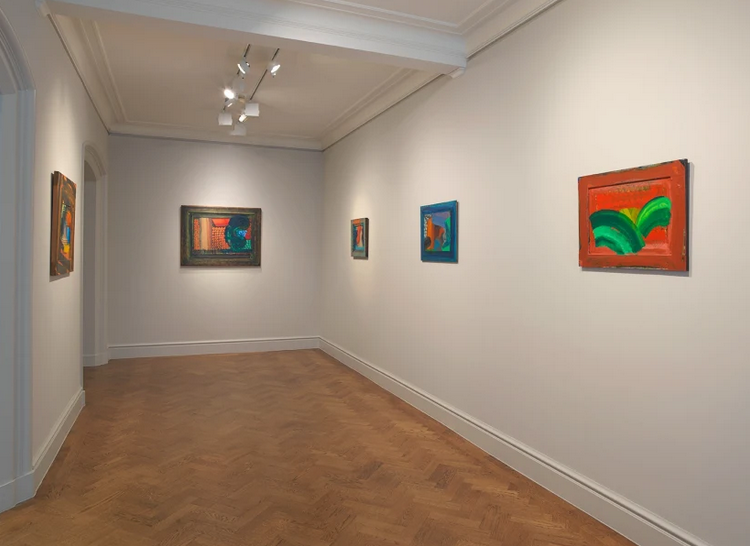
Commercial shows in town remain strong, with or without the fair. Dana Schutz at Thomas Dane is a relative ‘must see’ (until 19 December 2020), as is Howard Hodgkin at Hazlitt Holland-Hibbert (until 11 December 2020) and John Stezaker at Luxembourg & Co. (until 5 December 2020). Other presentations of note include Christina Quarles at Pilar Corrias (until 21 November 2020) and a historicising group presentation, Nude at Olivier Malingue (until 11 December 2020).
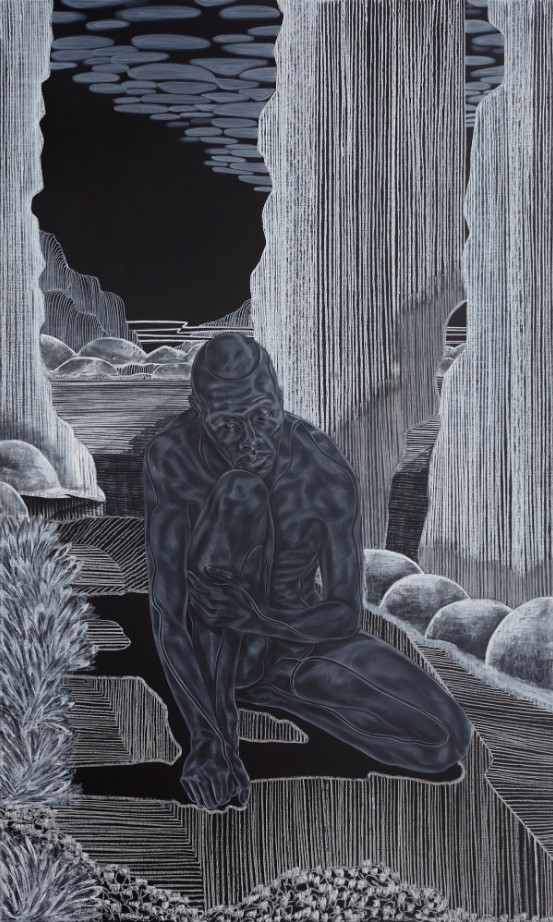
The autumn season also sees strong institutional presentations recently opened or soon to open. Critics and the commentariat have significant praise for Toyin Ojih Odutola’s solo exhibition at the Barbican (until 24 January 2021), and group shows including The Botanical Mind: Art, Mysticism and The Cosmic Tree at Camden Arts Centre (until 23 December 2020) and Not Without My Ghosts: The Artist as Medium at the Drawing Room (until 1 November 2020). Bruce Nauman’s retrospective at Tate Modern, the artist’s first major show in London for twenty years, presents one of conceptual art’s most provocative proponents in depth (until 21 February 2021).
Soon to open, and hotly anticipated, are the solo surveys of Lynette Yiadom-Boake (18 November – 9 May 2021, Tate Britain) and Zanele Muholi (5 November – 7 March 2021, Tate Modern). We’re also excited to see Tracey Emin / Edvard Munch at the Royal Academy of Arts (15 November – 28 February 2021). And, continuing the yBa theme, Damien Hirst’s self-mounted early career survey at the Newport Street Gallery (until 7 March 2021).
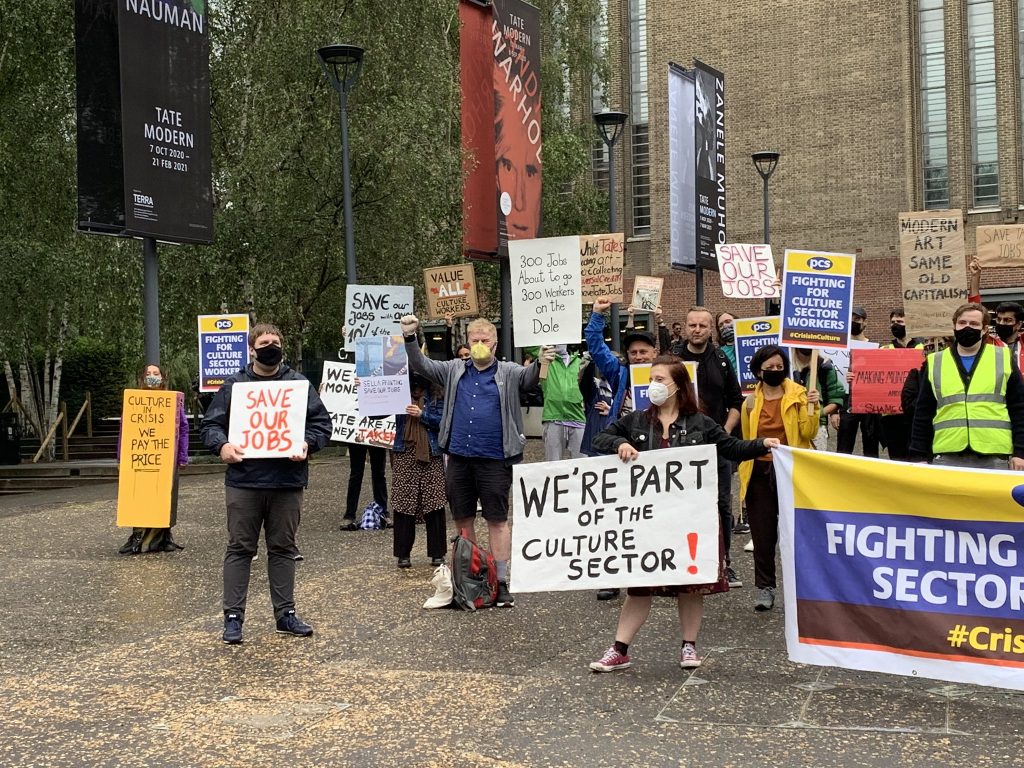
The woes facing the museum sector – Tate especially – are myriad. And staff at leading institutions, including the Royal Academy of Arts, have been vocal in their criticism of the organisation’s financial priorities following announcements of large redundancies and cost cutting. Commercial galleries are likewise working harder than usual to turn the wheels of commerce without the heat, buzz and noise of the art fair circuit. So the current outlook for the London arts scene is one of great resilience, yes, but also enormous flux. While a little stilted compared to other years, the exhibition schedule in London should remind us of its place – come what may in January 2021 with our departure from the European Union – as one of the world’s most important ecosystems for modern and contemporary art.
Image 1: Image courtesy The Art Newspaper; Image 2: Image courtsey Novaloca; Image 3: Image courtesy Cromwell Place; Image 4: Image courtesy Hazlitt Holland-Hibbert; Image 5: Image courtsey Barbican; Image 6: Image courtesy artnet news
FURTHER READING
- What Will Collectors Buy in 2022?
- Market Update: How the Art Market Joined the Digital Age
- Commentary: Will Online Platforms Kill Art Fairs?
“This is serious business and should not be trivialized.”
Managing Director Guy Jennings comments on the recent 20th Century Evening Sale at Christie’s, arguing that its distracting entertainment should not be taken lightly, nor detract from the sales results.
To read more of Guy’s insight into the content of the sales and the overall sales statistics, please click here.
“Collectors have already adjusted to considerable uncertainty [in 2020] in every aspect of their lives, and the industry as a whole has adapted at a remarkable pace to the radically transformed trading conditions.”
Senior Director Morgan Long comments on the latest Christie’s 20th-Century Evening Sale, and how it reflects that collectors have already fully adjusted to these times of uncertainty.
To read more about the auction results and the high-tech, live-streamed event, click here to read the article in full.
By Jonathan Levy, Head of DACH Region
The German-speaking Art world emerged from this year’s seemingly endless summer, with a hat trick of overlapping gallery weekends. Zurich, Munich and Berlin all opened their respective versions of the Corona-friendly format on the second weekend of September, to regional visitors anxious to experience Art IRL.
My forays took me to most galleries, museums and artist-run spaces in and around Zurich, followed by a day trip to Munich, where I was able to visit two extraordinary exhibitions at the Museum Brandhorst and immerse myself in the Bavarian capital’s gallery scene.
ZURICH ART WEEKEND
My Zurich Art Weekend started on Thursday evening, with a visit to Acrush, a production company on the industrial outskirts of Zurich. Acrush works with international galleries, museums and artists to realize ambitious large-scale commissions and exhibition projects. The impressive roster of artists includes names like Urs Fischer, Rob Pruitt, Paul McCarthy and the American artist, Darren Bader, with whom Acrush produced a special AI-experience to mark the occasion.
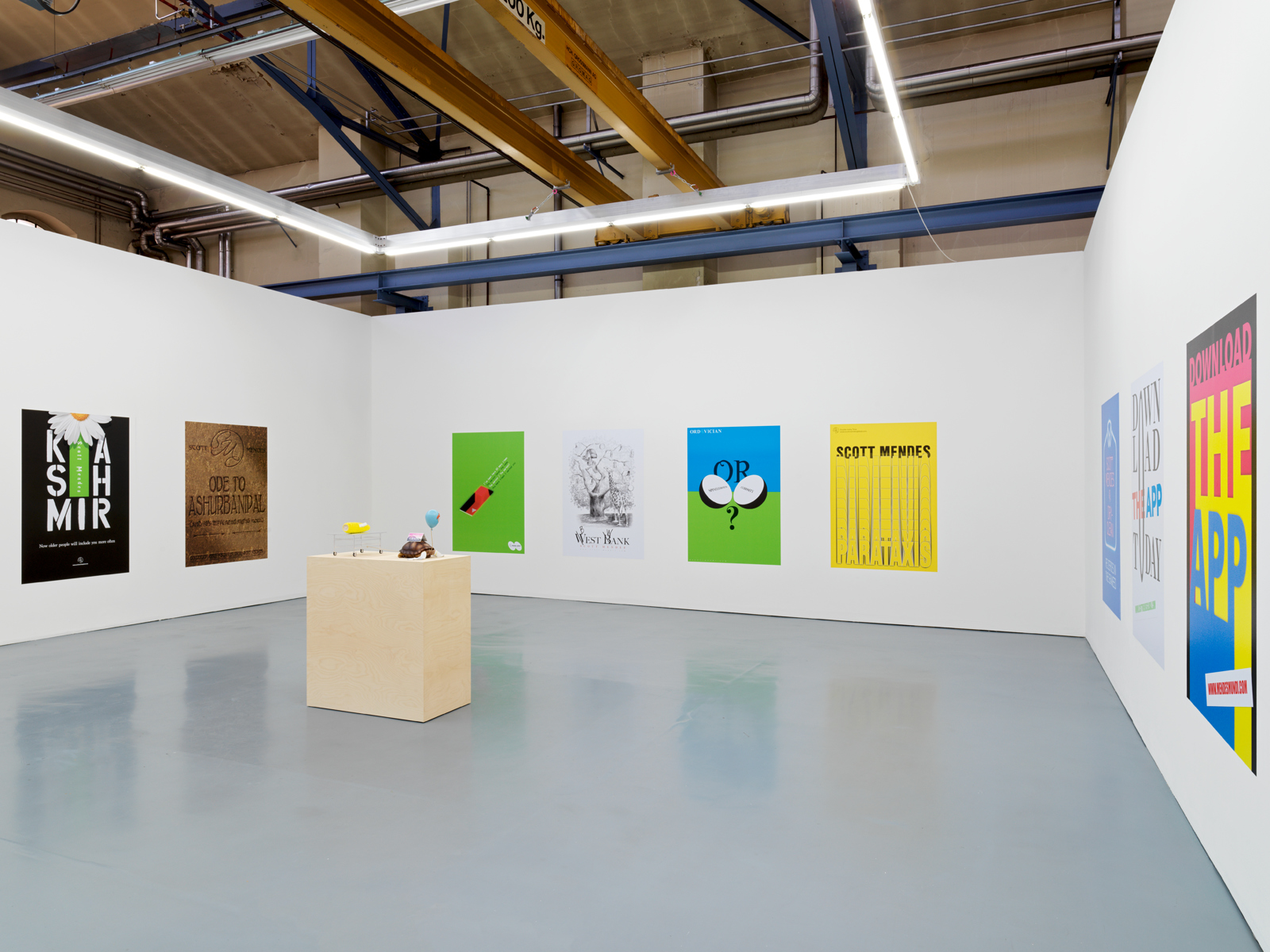
Bader’s work falls into a variety of categories, including “trash”- and “impossible” sculptures, “pairings” and “collaborative installations”. Using a range of experimental media, Bader explores inter-connections between seemingly disparate narratives and objects and presents the viewer with surprising and often humorous juxtapositions. In the current exhibition, entitled “Character Study”, Bader expands and confuses the object nature of art. He presents an experience in augmented reality that merges guided city walks in New York and Zurich, simultaneously. These walks are accompanied by an AR-character that can be produced and purchased in any desired scale. One version of the 3D character – part turtle, part cartoon – is placed at the centre of the exhibition space. The walls show posters of “Scott Mendes”, Bader’s fictitious travel agent, whom the artist developed as a mobile application for the 2019 Venice Biennale, to add an extra layer of content to the already crowded Arsenale and Central Pavillion exhibitions.
Over at Karma International, visitors are invited to explore the gallery’s massive 2-floor extension in an empty furniture showroom. The group exhibition in the new space combines exceptional works on paper by Meret Oppenheim and Bauhaus stage proposals by Xanti Schawinsky from the 1930s, with large paintings by Ida Ekblad and installation pieces by Sylvie Fleury, Pamela Rosenkranz, Ser Serpas and Vivian Suter.
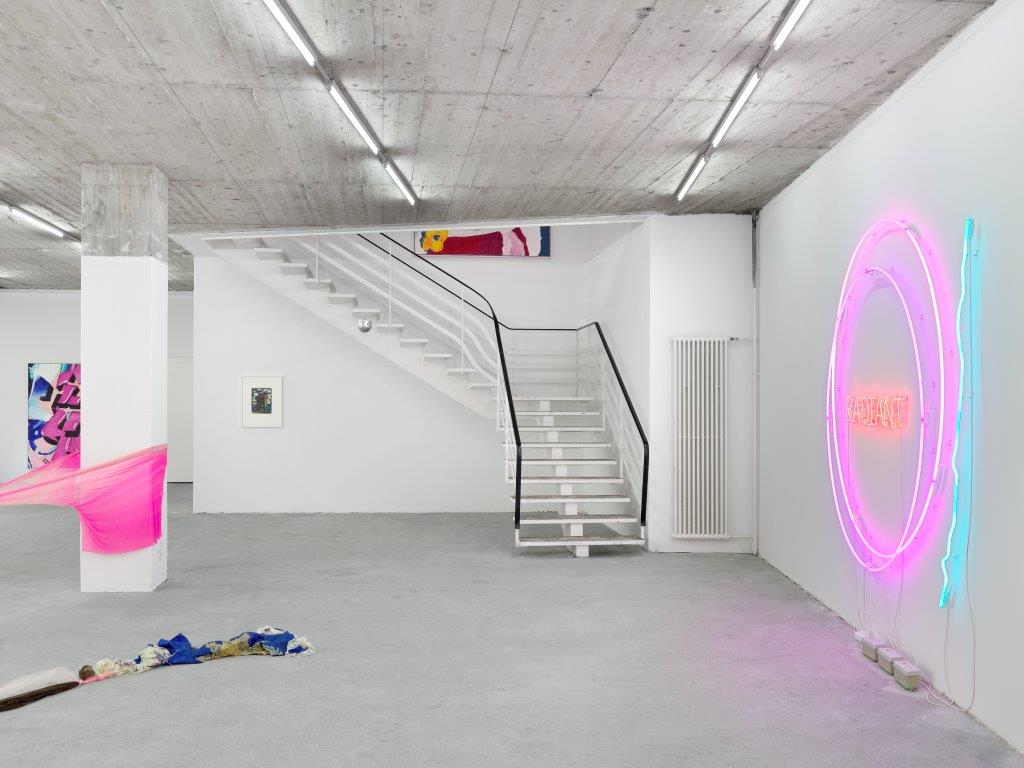
Across the street, the gallery presents an exhibition curated by former artistic director of Documenta, Adam Szymczyk. The show is dedicated to Elisabeth Wild, whose colourful geometric collages, made from found magazine clippings, contrast against works by Raúl Itamar Lima and Sophie Thun.
The Swiss response to London’s Mayfair gallery scene, is the area between the infamous Kronenhalle restaurant and the soon-to-be opened, David Chipperfield-designed Kunsthaus.
Opening on Friday afternoon, ZAW-visitors were invited to discover shows by Georg Baselitz (Levy Gorvy with Rumbler), Mira Schor (Fabian Lang Gallery), Jannis Kounellis (Larkin Erdmann), Matt Mullican (Galerie Mai 36) and Sarah Slappey (Gallery Maria Bernheim). Galerie Eva Presenhuber opened a new gallery on Waldmannstrasse, with a solo exhibition of large, colourful works by the American painter, Joe Bradley.
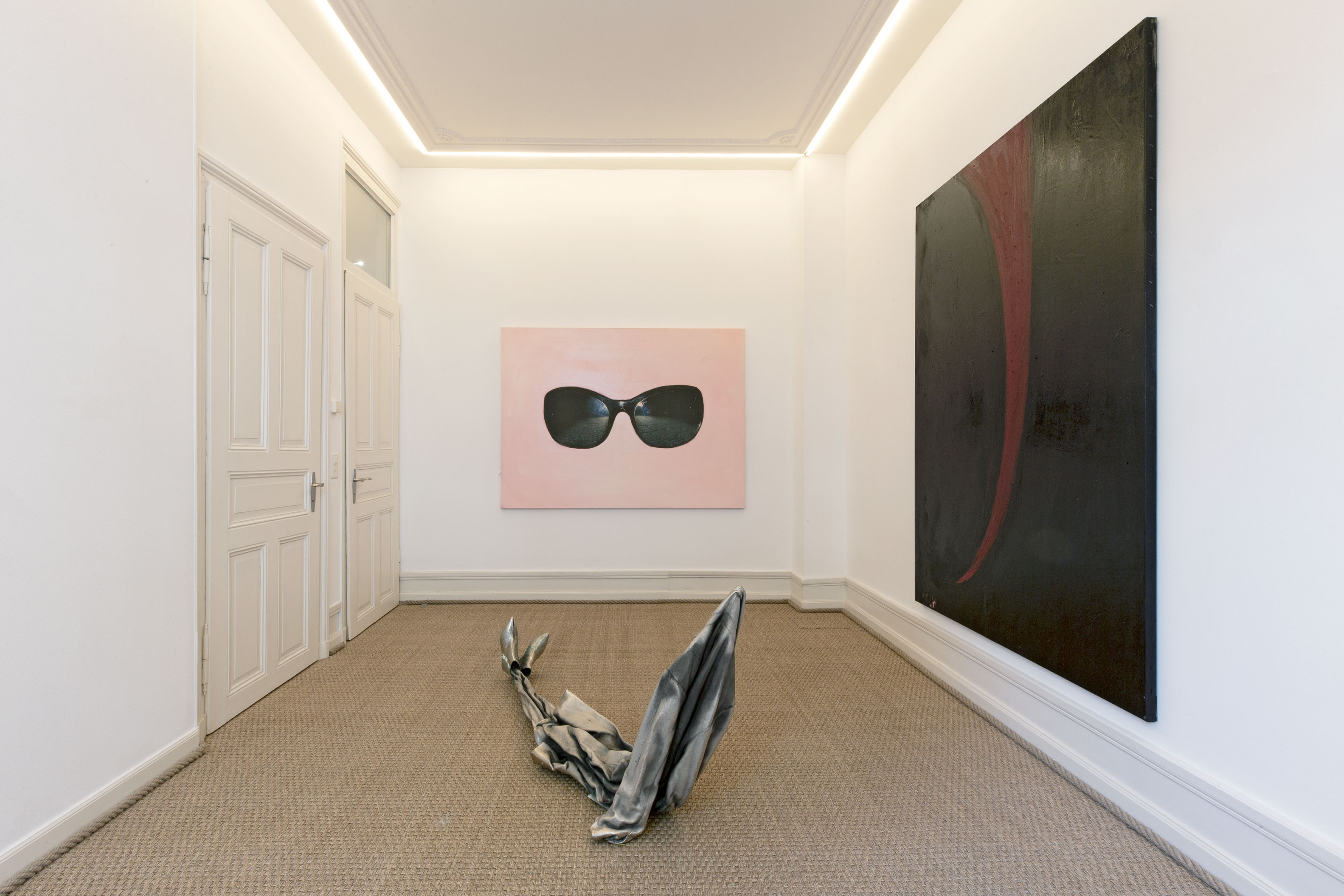
Next door, at Tobias Mueller Modern Art, visitors are greeted by wall-mounted installations and large paintings by American artists, including Julian Schnabel, Terry Winters, Virginia Overton, Philip Taafe and Tim Rollins & K.O.S (Kids of Survival). Climbing up the stairs to Galerie Bernhard on the second floor, we find an intimate display of new works by the Swiss-born, Berlin-based artist, Tobias Spichtig, whose paintings of sunglasses and resin sculptures of languid figures radiate the sense of primitive coolness inherent to underground youth culture, which creates the perfect transition from the elegant showrooms of uptown Rämistrasse to the local scene of artist- and curator run off-spaces that would round off my Zurich Art Weekend after a good night’s rest.
VARIOUS OTHERS, MUNICH
On Monday I left for Munich to catch the end of “Various Others”, a slightly different response to the Zurich and Berlin gallery weekends. The event is organized and hosted by VFAMK E.V., the Society for the Promotion of Munich’s External Perception as a Cultural Location. In this year’s edition the organizers asked local gallerists to host cooperative art projects together with other foreign gallery friends.
Galerie Nagel Draxler invited Lars Friedrich (Berlin) to its recently opened Munich dependence, for a sensual exhibition of paintings by the German abstract painter, Stefan Müller and a group of large scale leather leaves by the South Korean artist Min Yoon.
Other visiting galleries include Thomas Dane (at Jahn und Jahn), Sultana and Peres Projects (at Nir Altman), Emanuel Layr (at SPERLING) and Esther Schipper (at Walter Storms Gallery).
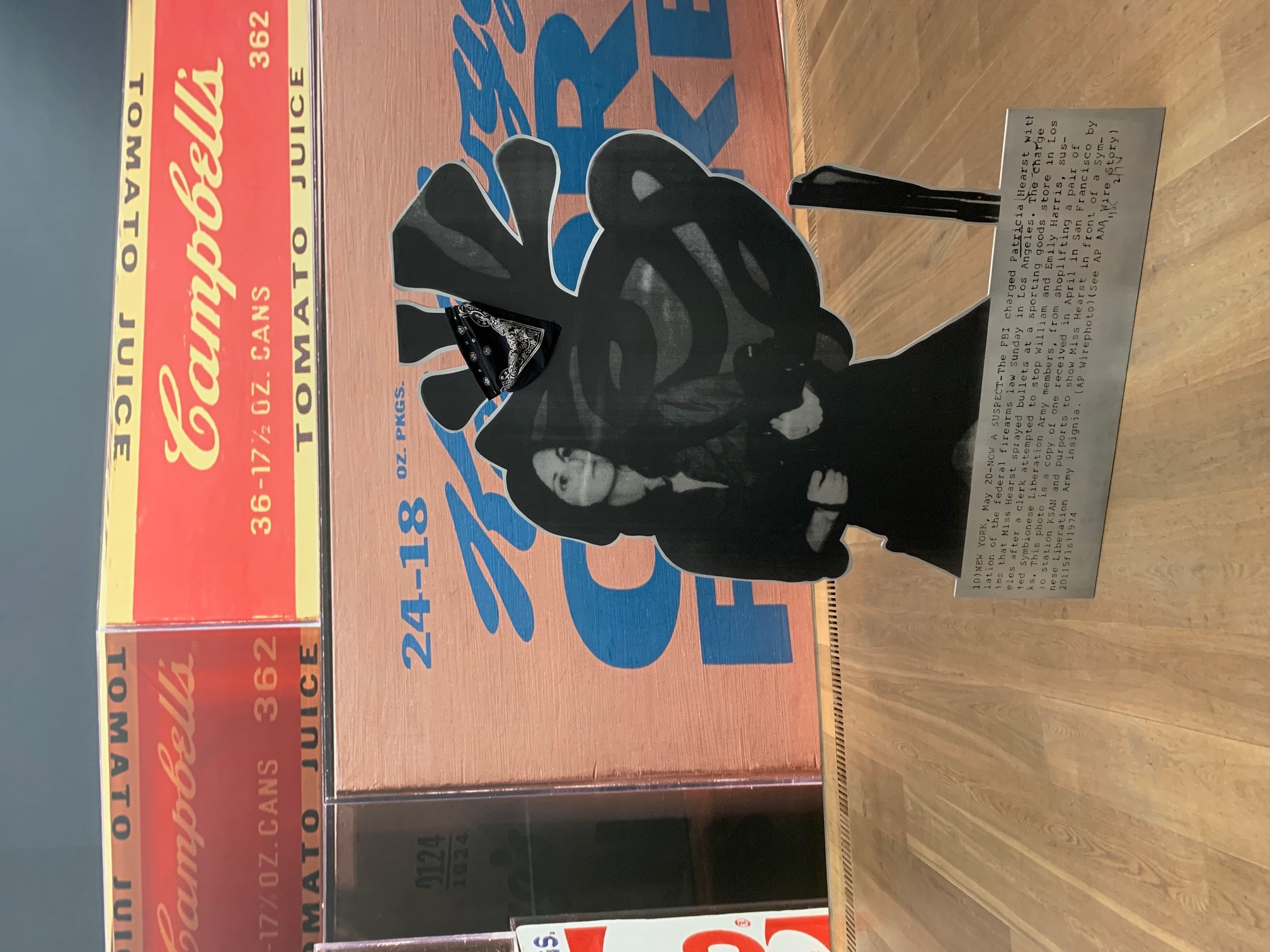
The highlight of my trip to Munich, however, was the impressive collection display at the Museum Brandhorst, and the fantastic mini-retrospective by Glaswegian artist, Lucy McKenzie (1977).
Walking into the museum, I stared down the barrel of Patty Hearst’s machine gun, in one of my favourite works by the American artist, Cady Noland. The menacing sculpture is placed against a huge backdrop by Louise Lawler and is flanked by two St. Petersburg-style displays of works by Andy Warhol. The Brandhorst collection spans the period from 1950 to the present day and boasts not only the largest collection of works by Warhol, but also substantial holdings of works by Cy Twombly that fill the entire upstairs galleries.
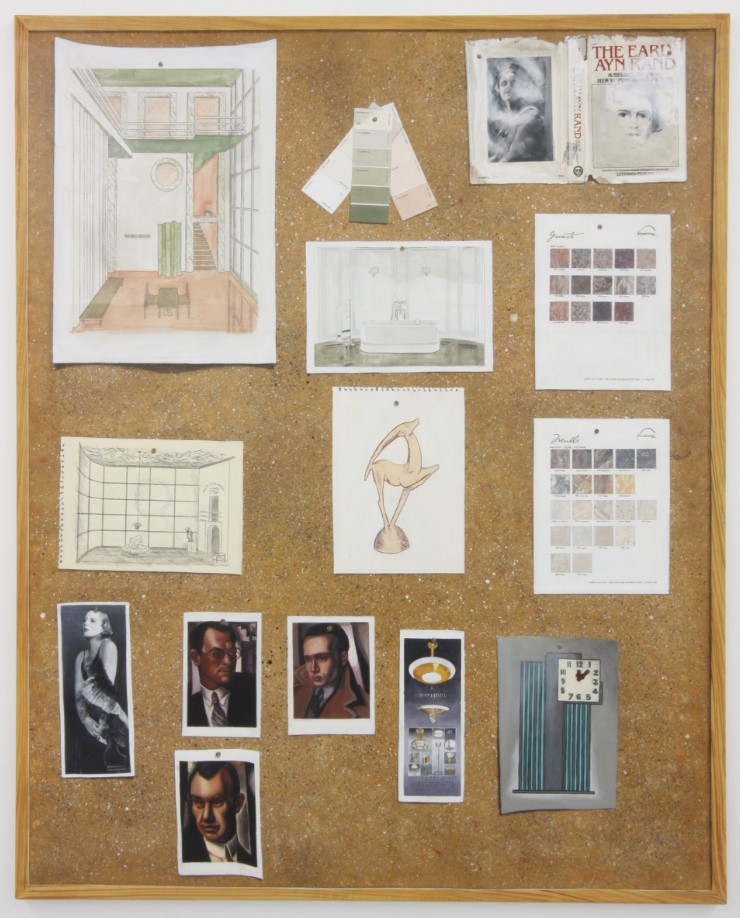
Walking down the large staircase into the museum’s belly, the first thing I notice is a long painting by Lucy McKenzie, entitled “Mooncup”, originally designed to mimic a multi-storey advertising banner. It leads into the artist’s first retrospective exhibition, which curator Jacob Proctor structures along the artist’s successive artistic phases. The show begins with a salon display of paintings, reminiscent of McKenzie’s Dundee diploma show in the late 1990s and moves through different iconic bodies of her work. The interest in painting and its conceptual potential was strongly influenced by German painters like Kai Althoff and Martin Kippenberger, whom McKenzie discovered during an Erasmus exchange in Karlsruhe. Her blown-up architectural maquettes reference the work of early modern architects like Charles Rennie Mackintosh and Adolf Loos. McKenzie creates fantastically immersive spaces that shrink the viewer and invite reflections on the power shared by architecture, design and authoritarian regimes. McKenzie’s further studies at the Van Der Kelen School for decorative painting in Belgium resulted in a series of “Quadlibet-”paintings. McKenzie uses these arranged inorganic still lives as powerful moodboards on which to experiment, juxtapose and confront themes of social and political tension. In one such moodboard McKenzie imagines the task of an interior designer, balancing colours, materials nd surfaces for a Fascist bathroom, with a glass door aptly labelled “Avanti”.
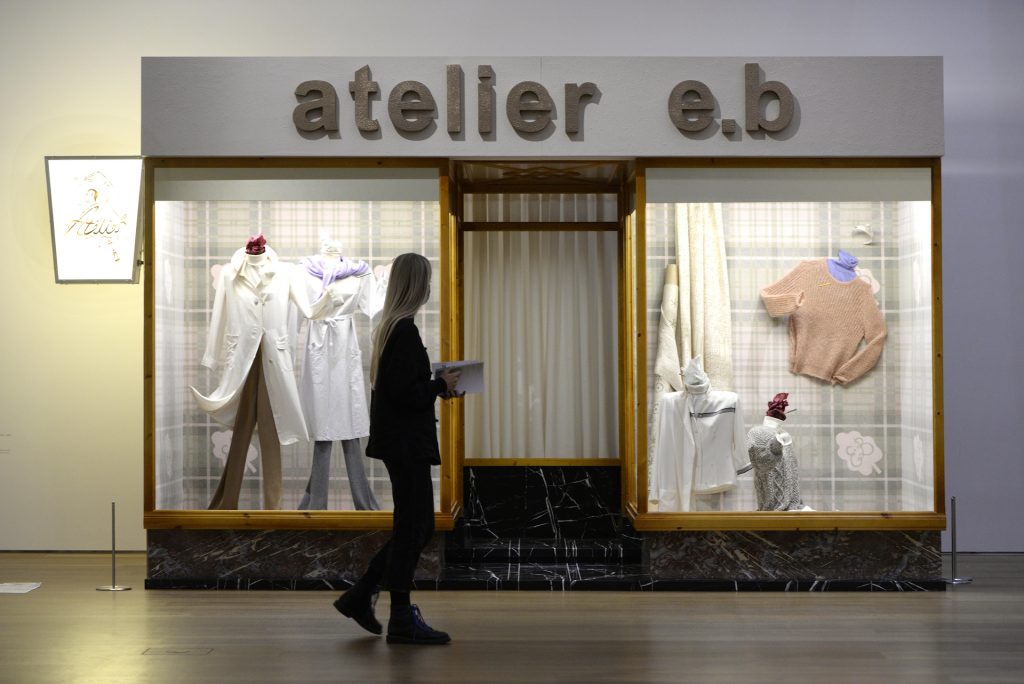
Delighted by the humorous, thought-provoking and enormously skillful display of Lucy MkKenzie’s work, I leave the museum in search of a typical Munich “Wirtshaus” and the hope that I will continue to be able to travel and experience more great exhibitions as the months get colder.
FURTHER READING
- Market Update: How the Art Market Joined the Digital Age
- Commentary: Will Online Platforms Kill Art Fairs?
- See You at the Fair?
The market has changed faster than ever before and two recent art market reports have added considerable detail to this picture. According to Artnet’s autumn 2020 Intelligence Report, fine art auction sales fell 60% from 1 January to 10 July 2020. The Art Basel & UBS Report – The Impact of COVID-19 on the Gallery Sector – records a comparable slimming of sales for surveyed galleries, with sales declining an average of 36% when compared year on year. How, then, has the market innovated in response?
Covid has clearly accelerated digitisation of the art market. Christie’s, Sotheby’s and Phillips held 131 online sales in the year to 10 July 2020, more than twice as many for the equivalent period in 2019. The move to seemingly continuous online sales has further driven down the average price for a work of art sold at auction by 41.3% (to 25,926 USD) compared with the same time last year, according to Artnet’s report.
Within the gallery sector, the ongoing digital migration has increased online purchases from 10% in 2019 to 37% in the first half of 2020. The Art Basel & UBS Report highlights further changes. Sales at art fairs have dropped from 46% in 2019 to 16% for the first half of 2020 as entire swathes of the calendar have been postponed or cancelled. Notably, commercial strategies have also shifted. Last year galleries listed their top priorities as art fair exhibitions and widening the geographical reach of their client base. Naturally the outlook for dealers is far more defensive in 2020, with cost cutting, development of online channels and maintaining existing client relationships now the order of the day.

Works on Paper from a Distinguished Private Collection. Pace, East Hampton.
Over the past decade the distinctions between dealers, auction houses, museums and art fairs have become increasingly blurred. Top tier galleries have long mimicked the reverential aura of museums; museums frequently use auctions to raise funds; auction houses now ‘curate’ sales and selling exhibitions; while numerous fairs contain thematic sections, some with entirely non-commercial ‘public’ presentations.
Recent developments continue this trend. Even before covid, Acquavella, Gagosian and Pace collaborated to win the revered Marron estate, intentionally challenging the received wisdom that such a significant assortment of high value works was automatically the preserve of the auction houses. In a recent profile of Pace Gallery for the Wall Street Journal (Michael Shnayerson, 9 September 2020), it was revealed that this initial collaboration has given rise to a longer term partnership – called AGP – that will compete for similarly important collections and estates in the future. Such collusion among fierce rivals is one of the more notable evolutions in response to the auction houses’ perceived encroachment on gallery turf.
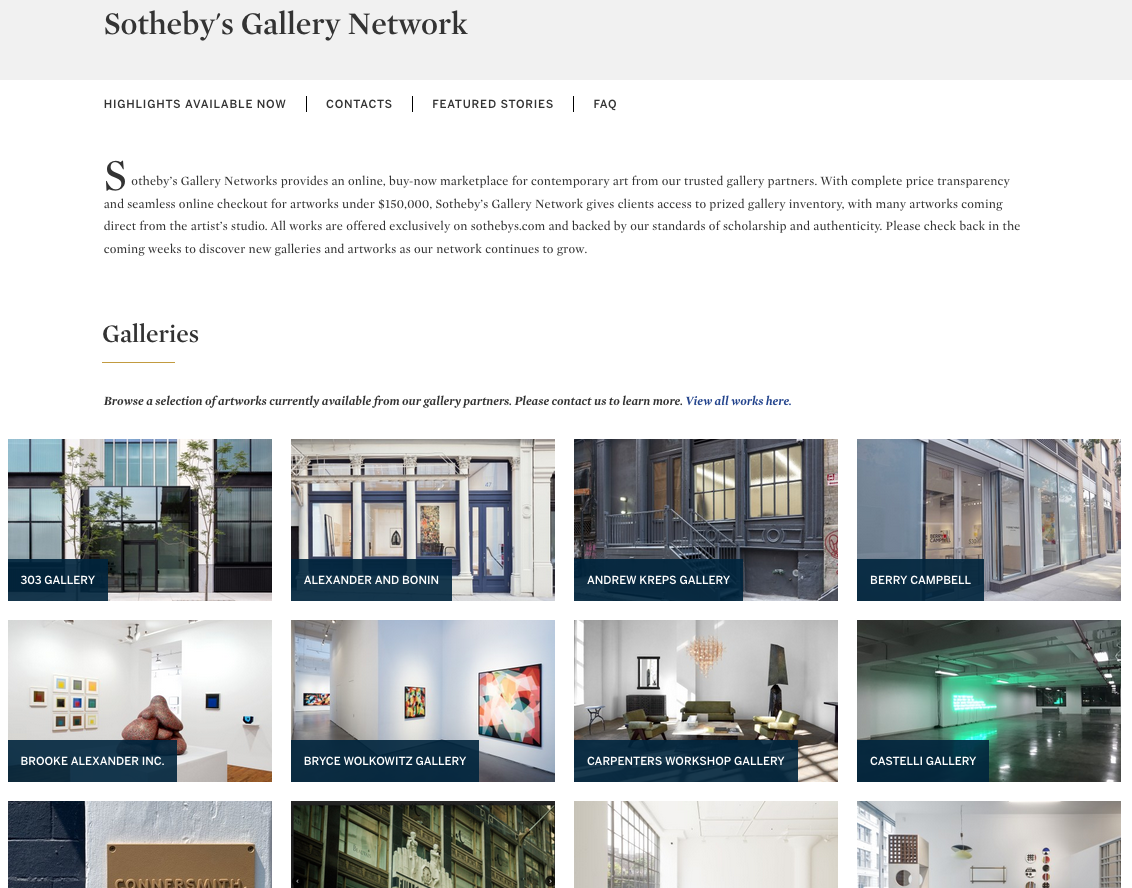
Despite competition for consignments, galleries and auction houses are also collaborating in new ways. Sotheby’s Gallery Network – an online, buy-now market place for works under 150,000 USD – hosts virtual storefronts for 34 dealers including 303 Gallery, Andrew Kreps, Fergus McCaffrey, Lévy Gorvy and Peres Projects, among others. Such partnerships would have been unimaginable not long ago. While quality of works is mixed – most dealers don’t want prime stock available to anybody at the click of the button – it demonstrates the softening of traditional enmities in a moment of crisis. For the time being, at least.
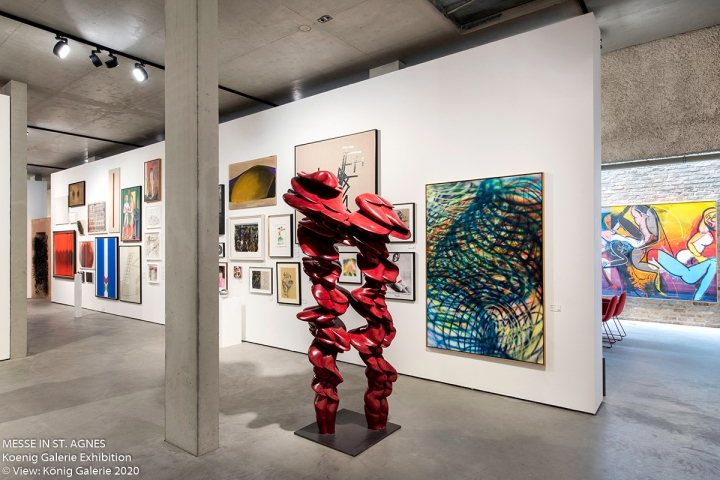
Messe in St. Agnes. König Galerie.
In Berlin, König Galerie is hosting Messe in St. Agnes #2 from 12 to 20 September. A ticketed selling exhibition – hung salon style – with primary and secondary market consignments, the enterprise was an unusual but apparently effective way of generating revenue in the ultra-contemporary Berlin gallery scene which has historically demurred from such outright mercantile endeavours. Lingering somewhere in the murky interstitial space between art fair, auction hang and selling exhibition, the project seems an intelligent way of maintaining close contact with gallery clients looking to offload works or trimming collections as a consequence of long periods of confinement at home.
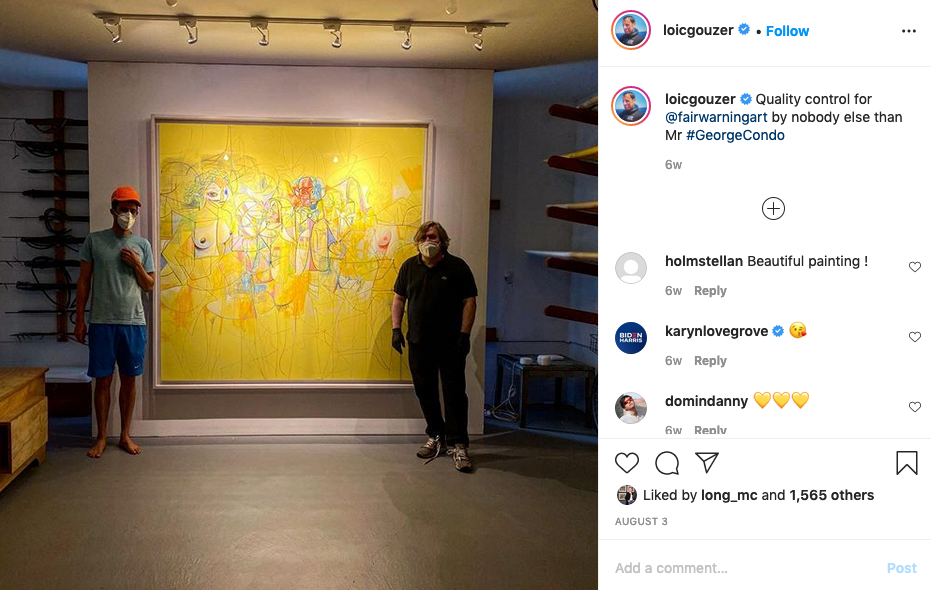
One of the most successful new ventures to join the fray is a new concept remarkable for its simplicity. Former Christie’s ‘rainmaker’ Loic Gouzer has developed an invitation only auction app, Fair Warning, which offers a single work at auction on an almost weekly basis. Auction participants are closely vetted and results have so far been impressive. Pieces by Steven Shearer, David Hammons, Steven Parrino, George Condo and others have all been offered, with the highest price to date achieved for an Untitled 1982 Basquiat work on paper, which sold for 10,810,000 USD premium. Not bad for a sale orchestrated from a garage on Long Island, albeit the Hamptons end.
While historically resistant to the technological ‘disruption’ so common in other industries, the art market has found the inclination this year to be a little more experimental. Most market commentators are united in welcoming the silver lining of greater price transparency from the migration online. In this alone, 2020 may have delivered a meaningful transformation for the industry.
Image 1: Image courtsey Gagosian; Image 2: Image courtesy Sotheby’s Gallery Network; Image 3: Image courtesy König Galerie; Image 4: Image courtesy @loicgouzer
Further Reading
Inaugurating Modern Art’s new space on Bury Street is a group of recent paintings by Austrian artist Martha Jungwirth. Born 1940 in Vienna, much of her reputation, influence and exhibition history has been confined to central Europe. Although recognised during the 1960s – 1970s (she participated in Documenta 6, 1977) she had since faded from international view until 2010, all the while remaining an important figure in the Vienna art scene. This turning point is often linked to the inclusion of her work in a group show curated by German painter Albert Oehlen at the Essl Museum in Austria that year. While many of the subsequent commercial exhibitions over the past decade have presented historical bodies of work, Modern Art’s new exhibition presents paintings and works on paper from the past few years.
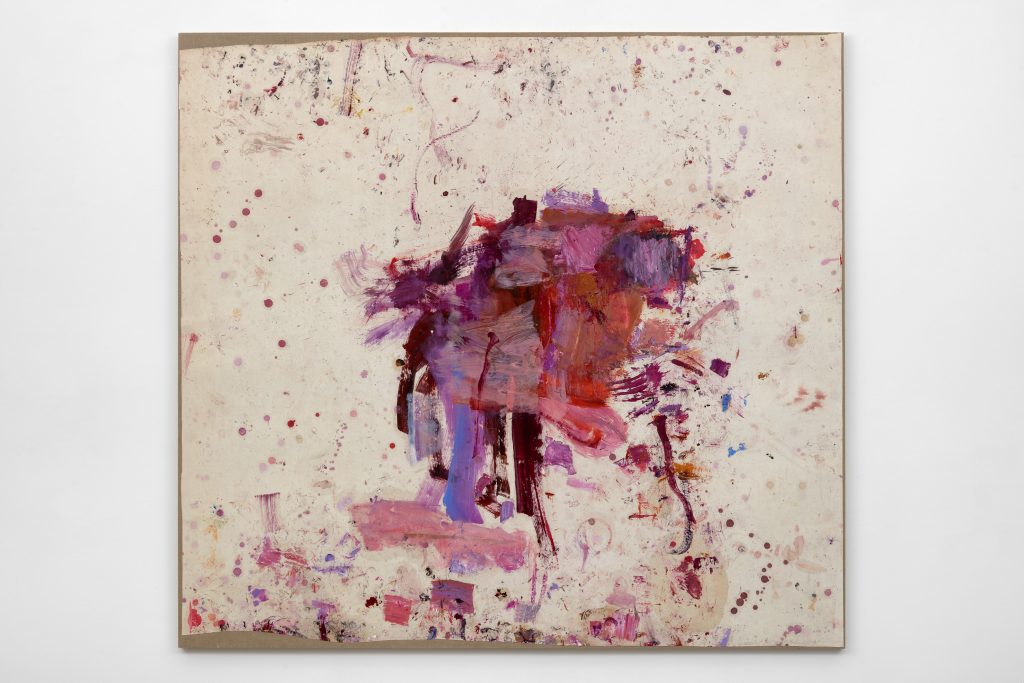
Jungwirth’s work elides numerous art historical genealogies while somehow standing apart from them. Studying in the 1950s and early 60s, the prevailing artistic winds of the time are evident in her handling of mark and gesture. Cy Twombly and Joan Mitchell are often mentioned, and there’s certainly a lyrical nature to her late career abstraction which might be traced to the tail end of Abstract Expressionism. Like numerous artists of her generation, the lingering presence of Surrealist interests – especially automatism and the role of chance – greatly inform her practice.
One of the most notable aspects of her work is the prominence of touch, centre stage. Her surfaces are splattered, stroked, stained, dragged and brushed into existence, while large expanses of empty sheet are left lightly touched, leaving the buff brown of the card she often uses to become a primary component of the overall personality of each work. As such, her gestures have been likened to ‘actors on a stage’: individual marks dancing with each other across the sheet.
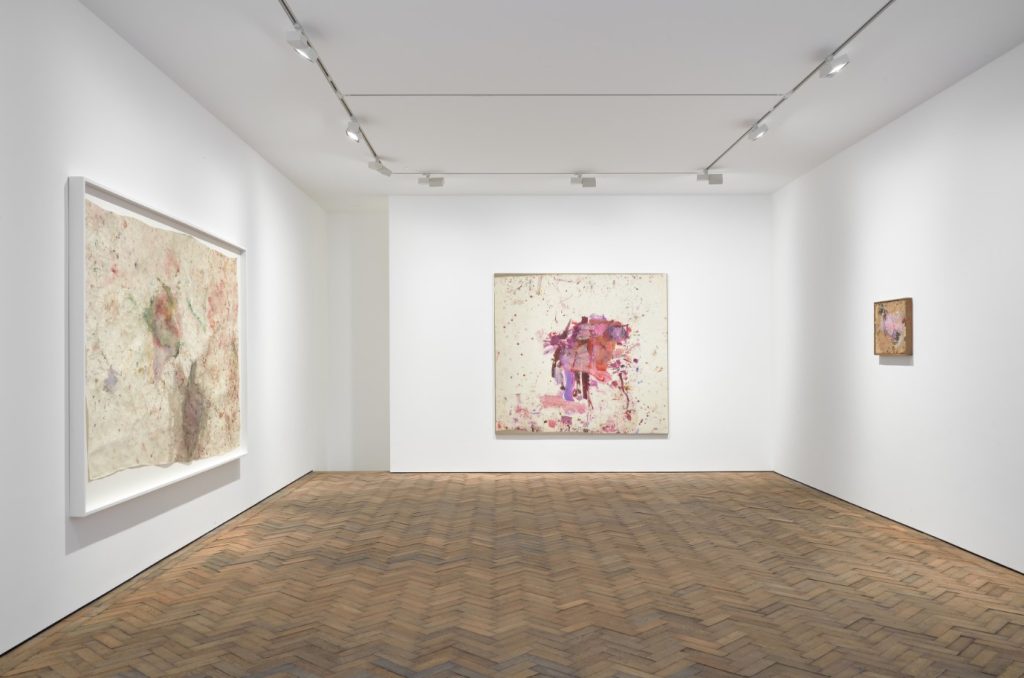
Numerous works in oil are marked by purposefully visible, paint-y finger prints from where the artist has handled the sheet in the studio. Understood art historically, these could be seen as a sort of joke on the dogmatic clash between AbEx with Pop and Minimalism in the 1960s. Where AbEx asserted the singular authorship of the artist as a uniquely endowed creator of meaningful works, Pop and Minimalism – in line with left-leaning literary theory of the time – denied the ‘hand of the artist’ almost entirely. Perhaps given a further twist, the predominant shades in recent works are bright pinks, rich maroons, vivid reds and deep purples – a decidedly fleshy, even bruised, palette. Whether understood as a record of a performative act, or a physical encounter with the artist’s touch, the body is consistently evoked in her work as painterly presence.
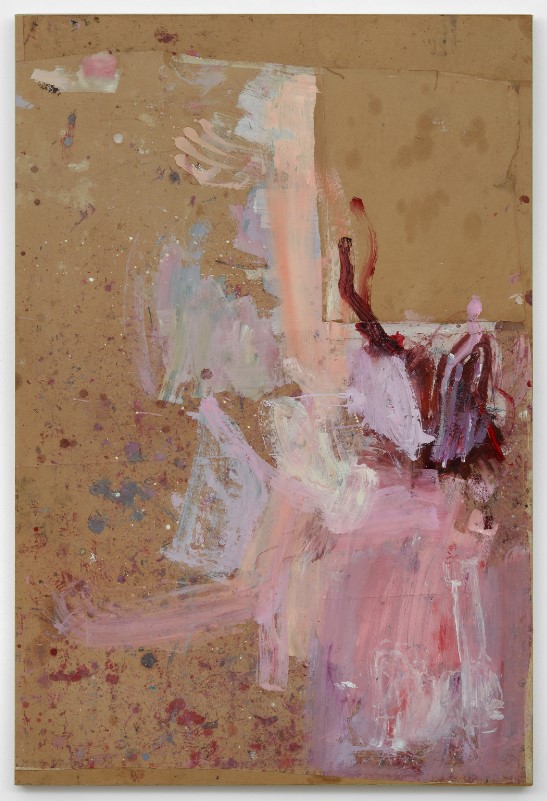
The title of a solo show in 2013 at Galerie Cinzia Friedlaender, Berlin provides further insight on her views to the artistic milieu of her early career. Pädagogisch wertlos – translated as Devoid of Pedagogical Value – may refer to her ten years as an art school professor in Vienna, but could well be a rejoinder to see the value of her work in tactile, visual pleasure. Where so much of AbEx was high-minded (even quasi-spiritual in the case of Rothko) – the show title suggests that retinal pleasure is as important, if not more so, than lecturing the viewer with a diffuse, overbearing rhetoric beloved of many mid-century abstractionists. Perhaps a plea to see colour as colour, and to enjoy it as such, rather than as an existential cry into the abyss.
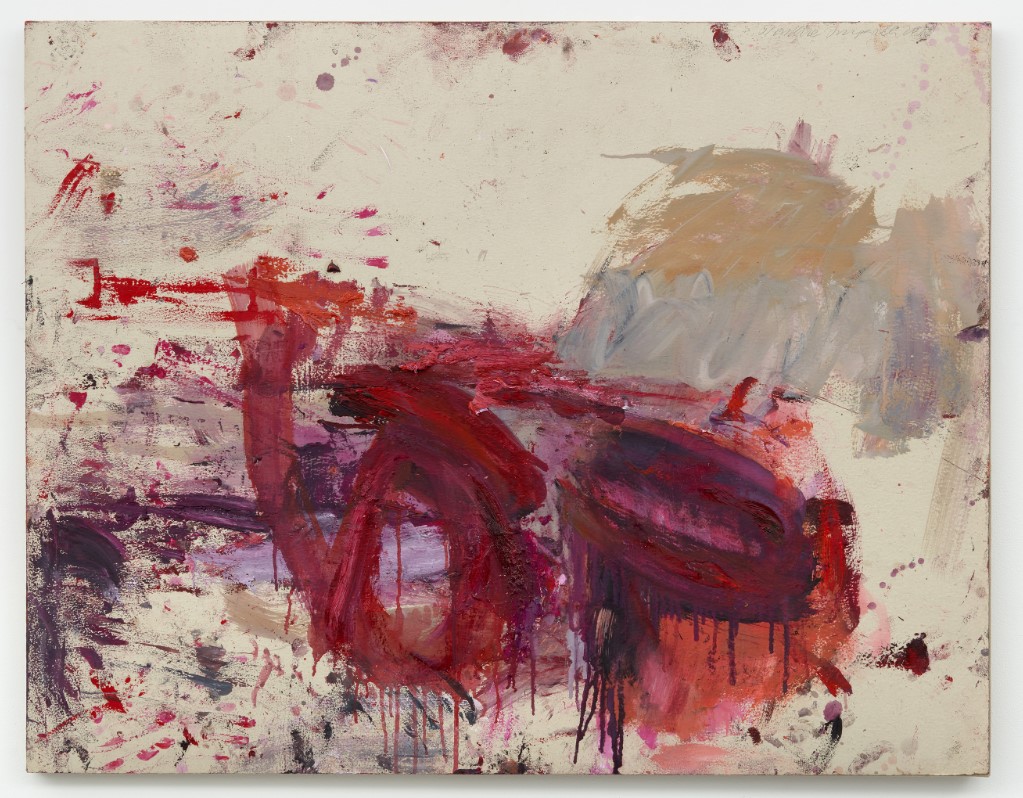
Guilty, like many, of coming to her work in the past decade we’ve followed this later career reappraisal with considerable attention. Market interest has become fierce in recent years, with an auction record of 80,000 EUR (with fees) set in March 2020. While her work rarely left central Europe for many decades, those further afield – such as the Rubell Family Collection in Miami – have now acquired her work in depth. Likewise a show at Fergus McCaffrey, New York in 2019 was the artist’s first commercial exhibition outside Europe. As such the current presentation at Modern Art, closing 26 September 2020, presents a cherished opportunity to see a new body of recent works in the round. Not to be missed!
Banner Image: Copyright Martha Jungwirth. Courtesy the artist and Modern Art, London.
FURTHER READING
- May 2023 Auction Season: Our Team’s Top Picks & Insights
- The Educated Eye: Understanding the Hermès Luxury Handbag Market
THE ART MARKET & COLLECTORS IN 2022
Reinvigorating the ‘heat’ and associated public relations noise around the global calendar of auctions and commercial exhibitions is one key challenge facing the art market in the medium to long term. Another is the covid associated disruption to a huge variety of ostensibly non-commercial activities which are often the art historical engines propelling value growth for young, old and dead artists alike.
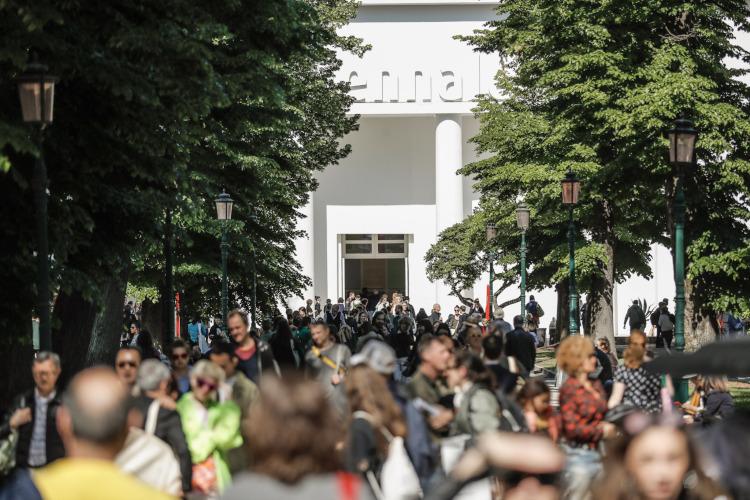
The Venice Biennial, for example, has been moved to 2022. While the 2020 Turner Prize will now comprise a proportionate cash prize to ten shortlisted artists rather than announce a single winner. Museum exhibitions around the world have also been put on hold (although some are now beginning to reopen) which further softens the positive impacts that might have been elicited by institutional solo exhibitions, major monographic surveys or permanent collection acquisitions. Many institutions are also now fighting for survival. With drastic cuts to exhibition budgets or outright closures, the art historical and intellectual capacity of the visual arts ecology may well contract markedly in the next twenty-four months.
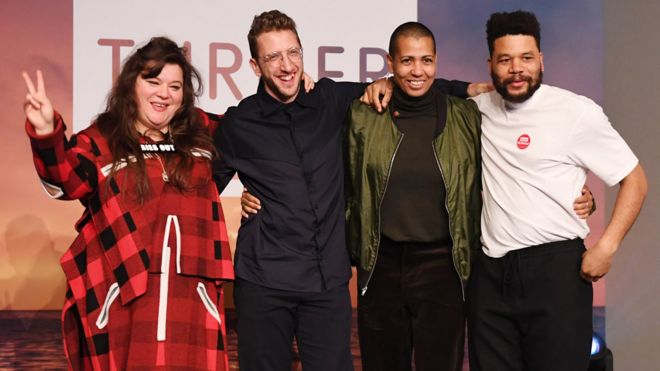
Understanding the impacts this may have on market trends and values remains to be seen. Several trends at lower price points were especially evident pre-covid – figurative painting by mainly female artists addressing identity politics, for example – while artists at the other end of the spectrum, such as Alex Katz, were enjoying major late career market jumps.

Recent auction results have shown collectors’ predisposition to proven names at sensible prices. But the new stars of tomorrow, the long forgotten late career artists ripe for ‘rediscovery’ and the next hot artist estates will not be anointed in 2020, or perhaps even 2021. Collector tastes may also change as they invariably do following seismic global changes. Look, for example, at the market of Anselm Reyle. Eight of his top ten auction records were achieved in 2007 – 08 in the heady, frothy days before the economic crash of 2008 – 09. His market has since dived in value and is only just beginning to recover. Given the current situation might take twelve, eighteen or twenty-four months to solve itself globally, tastes may shift significantly before they begin to make themselves apparent in the galleries and salerooms.
With the art world – to an extent – preserved in aspic at a moment from February 2020, it may not be until the summer of 2022 that we see a global visual arts ecology establishing and validating financial and art historical value in a fully functioning manner at all levels as it was before.
OUR SERVICES
Offering expert Advisory across sectors, our dedicated Advisory and Sales Agency teams combine strategic insight with transparent advice to guide our clients seamlessly through the market. We always welcome the opportunity to discuss our strategies and services in depth.
Image 1: Image courtesy La Biennale di Venezia; Image 2: Image courtesy BBC News; Image 3: Image courtesy Phillips
FURTHER READING
- Why Serious Collectors Need Professional Collection Management Services
- El Niño 2023: Are Your Art & Collectibles Protected?
- Market Update: How the Art Market Joined the Digital Age
PART IV: ART BASEL DURING THE COVID-19 PANDEMIC
Art Market Pulse is a timely 4-part video series presented by The Fine Art Group. Each episode, we will offer an informative view on the current state of the art market, taking the pulse of real-time developments. Providing access and insight, viewers will hear intriguing conversation from top executives within the art industry.
In the final episode of Art Market Pulse, The Fine Art Group’s Founder and CEO Philip Hoffman sits in conversation with Art Basel’s Global Director, Marc Spiegler.
Find out how Art Basel, the world’s most prestigious art fair, is adapting and innovating to meet the needs of its participating galleries and collectors.
Watch the full video here:
https://www.ubs.com/global/en/our-firm/art/2020/pulse-video-series.html?campID=CAAS-ActivityStream
